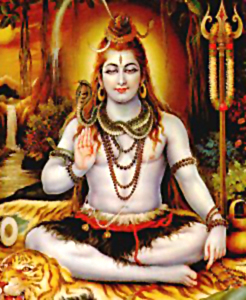 Yogis are basically Saivites. They have faith in a number of deities or pantheons. According to some researches, there are several deities of Gorakhnathis. The range of their interests and of their historical connections includes several elements. Like for instance, the images on the face of the Dharamsala on the top of Dhinodhar serve as an illustration. Hanuman and Ram Chandra have their shrines at certain monasteries, such as at Tilla, and both, together with aspects of Vaisnavism, and even Vishnu himself, are assimilated to certain division of the Gorakhnathis and are mentioned in popular legends. The image of Garuda is found in the establishment at Puri whereas Lord Hanuman is represented in certain forms of the tika. The rudraksa of ten faces symbolizes the ten avataras of Lord Vishnu. At Gorakhpur the decorations on the samadhs and shrines contain many Vaishnavite symbols and images. According to the Siva Samhita the chanting of the name of Lord Vishnu is necessary in Yoga practices when the attention is directed to the chakras.
Yogis are basically Saivites. They have faith in a number of deities or pantheons. According to some researches, there are several deities of Gorakhnathis. The range of their interests and of their historical connections includes several elements. Like for instance, the images on the face of the Dharamsala on the top of Dhinodhar serve as an illustration. Hanuman and Ram Chandra have their shrines at certain monasteries, such as at Tilla, and both, together with aspects of Vaisnavism, and even Vishnu himself, are assimilated to certain division of the Gorakhnathis and are mentioned in popular legends. The image of Garuda is found in the establishment at Puri whereas Lord Hanuman is represented in certain forms of the tika. The rudraksa of ten faces symbolizes the ten avataras of Lord Vishnu. At Gorakhpur the decorations on the samadhs and shrines contain many Vaishnavite symbols and images. According to the Siva Samhita the chanting of the name of Lord Vishnu is necessary in Yoga practices when the attention is directed to the chakras.
There are several deities of Gorakhnathis and it is clearly proved by Buddhist elements and contacts that are numerous. Not only is the Tantra-Yoga system, which the Yogis follow, a mixture of late Buddhism with Brahmanistic elements, but also the history of the Kanphatas shows many Buddhist marks. In the state of West Bengal, Matsyendranath, Gorakhnath, Hadi and others art claimed as Buddhist saints. According to Bengal traditions Gorakhnath was originally a Buddhist by the name of Ramanavajra belonging to the Vajrayana. He became a convert to Saivism, took the new name, and became the great protagonist of the latter cult. One of the Yogi castes of Bengal is still known as the Dharmagiri Yogi. Sankara was a great protagonist of Saivism in the east. The struggle continued for centuries before Buddhism was overcome. Elements of it still persist and continue in modern forms of Tantric Hinduism. Ramifications of the sect of the Kanphatas in the north-west and beyond the borders of India, clearly point to Buddhist influences.
The chief concern of the Kanphata Yogis is, however, with Lord Shiva and the Saivite faith. In the symbols everywhere in evidence at the sacred places of the Gorakhnathis, in the legends and in ceremony, Shiva and his consort are always to the front. The festivals at numerous establishments of the Kanphatas are peculiarly Saivite. At Dhinodar, for instance, the head of the monastery repeats a hymn in Lord Shiva`s honour on the second of every month. With Shiva is associated the bull, and the phallic element in his worship is always present. The samadhs of the Yogis are surmounted by the yoni-linga; these emblems are symbolized in the singnad and the pavitri of their sacred thread; the brand mark that the Yogis receive at Kotesvar is a representation of these same figures; and, of course, every temple of their sect contains these symbols. The worship of the linga is very old in India, and it is probably because of its origin from aboriginal sources.
Lord Shiva is worshipped by the Kanphata yogis and the Saktas. According to their popular legends, Shiva has several forms (from eight to twelve), but he is best known as Kal Bhairon. Kanphatas, who worship the linga and the yoni, hold restraint of the passions is unnecessary for the attainment of samadhi. Thus, it shows that the several elements associated with the Sakta system are described as main practices or doctrines of the Kanphata yogis.




















